It’s Not a Car, It’s Your Driving Entertainment Screen

When the M&E industry switched from 35mm film to digital/IP-based content it marked the beginning of a whole new set of opportunities for nearly everyone inside and outside the industry to make content and make a buck.
Unwittingly, it also marked the slow death of one of a guy’s/gal’s greatest teen memory-makers the drive-in theatre.
Seriously, our kids will never know the excitement/anticipation of connecting with your significant other (at the time), going to the drive-in at dusk and waiting for the sun to slide over the horizon so we could occasionally look through the steamed-over windows to watch the movie.
Sure, there are a few diehard drive-in owners; but from a high of 2400 locations in 1980, there are less than 300 across the US today.
Yes, the value of the drive-in’s land contributed to the demise, but also it costs about $100 grand to upgrade to digital projectors (stronger bulbs needed).
So, to give SMPTE (Society of Motion Picture and Television Engineers) Annual Technical Conference attendees a vision of tomorrow – replacing the drive-in theater with the in-drive theater.
Deloitte’s Richard Merchant and Scott Corwin along with Intel’s Doug Davis paved the way with all of the logical reasons the self-driving vehicle will be the daily transportation for people in the future.
Warner Bros’ Pam Allison, Framestore’s Mike McGee, and BMW Group Designworks’ Eric Brown did a great job of selling us on the fact that we wanted really mobile entertainment sooner rather than later.
The only problem it’s going to be later rather than sooner because a whole lotta technology/technical details have to be tested, refined, tweaked, proven and deployed before we pop popcorn and climb into our vehicle to let it drive around while we enjoy the show.
We agree it’s gotta’ happen!

All-electric or hybrid vehicles are vital to decrease our need for environment-polluting fossil fuels.
In addition, intelligent autonomous vehicles will save lives (1.3M every year worldwide) and will keep 20-50 times that many (20-50M WW) from being injured and disabled.
But they’re going to come in slow, painful phases over years – some optimists say by 2020 while sane folks say it will be 2030-2050 before all of the pieces are reliably in place.

The SAE (Society of Automotive Engineers) established the various levels of autonomy which governmental agencies and manufacturers are using as guidelines for the world’s autonomous vehicle progress.
All of the SMPTE speakers pitched the coming of people’s third living space (the car) and obviously the new way for us to consume entertainment.
And BAM! even before we backed out of the garage with one of the new L3 cars; Gerry Purdy, principal analyst at Mobilicity, pointed out to us that we hit our first bump in the road … the infotainment system.
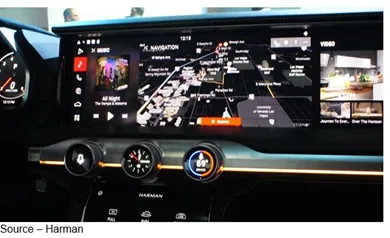
We didn’t really think much about it at last year’s FMS (Flash Memory Summit) when Harman’s Ivan Ivanov spelled out the type and amount of storage his firm needed in the years ahead to quickly and reliably store and handle data for tomorrow’s autonomous transportation – hint, it’s a ton!
Throwing in more storage is “almost” the easiest part for Harman’s and Ivanov’s team because even if you only have an L2 or L3 car right now, it’s more than some folks have simplistically called it “an iPhone on wheels” and it’s going to do more … lots more.
If we use the navigation in our F Type, we have to be parked and plug in the address (doing it on the road is ridiculously difficult).
We stick with the same music streams, so that’s okay.
We can’t plug in numbers to call someone or type in text because we know our limits.
A recent University of Utah study found that all of those sexy touchscreen features diverted too much attention away from safe driving (an average of more than 40 sec).
Interestingly, they found in-vehicle voice-based features were also distracting (but far less so, 30 sec).

“Using voice-commands to control infotainment system functions resulted in lower levels of visual demand than the other modes, the study notes. “However, the benefits of reduced visual demand were offset by longer interaction times.”
Marshall Doney, AAA’s president noted, “Drivers want technology that is safe and easy to use, but many of the features added to infotainment systems today have resulted in overly complex and sometimes frustrating user experiences for drivers.
“Automakers should aim at reducing distractions by designing systems that are no more visually or mentally demanding than listening to the radio or an audiobook,” he added.
Still, we prefer to talk to the system rather than trying to hit the right letter/number/instruction.
Buy an L2/L3 vehicle and the first thing the sales person does is train you how to work with, talk to the infotainment system.
We’re right back in the old smartphone closed gardens using the apps the auto manufacturer and infotainment system people decided are best for you.
We left the captive world over the years when we upgraded from Blackberry to Motorola Razr to iPhone and whatever new phone we decide to get tomorrow.
If they negotiated a deal with Amazon, Google or Apple; you start your conversation with Hey Google, Alexa, Siri or someone else’s voice. Then, you use the apps that were installed – Sirius or IHeart, AccuWeather or Weather Channel, Google Maps or Waze.
We’re not interested in a thousand different apps today in our L2 car or tomorrow’s L3 vehicle; but by 2025/30, we may need new apps to keep us awake as we sit in traffic.
We were surprised when AT&T proudly announced more than 27 million vehicles were subscribing to their service and that they had more than 1M mobile Wi-Fi hotspot subscribers.
Wait a minute!
The AAA urges automakers to design systems to block text messaging, social media and programming navigation while the car is in motion.
Government agencies even enacted laws to say doing those things and holding the phone/talking and driving was illegal because people who live on the phone can also die on the phone.
But according to telcos and equipment suppliers, things will be better when they deploy high-speed wireless technology (5G)–not just for phones but tomorrow’s vehicles and roads.
Faster data speeds will make it better, easier for connected things to safely communicate with each other, bringing data to and from the vehicle to provide a safer, more relaxing trip.
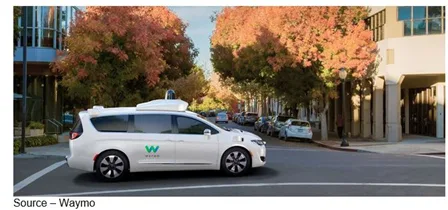
Today’s 4G LTE connections do a pretty good job today, which is why Waymo is conducting driverless tests in our area. Each vehicle has two people in the car to respond to situations. We think the second one is there in case the first falls asleep.
But they are not alone on the road.
Every auto manufacturer and tech company is conducting autonomous trials and the wireless industry is positive that as soon as they get the world connected by 5G things will move even faster.
The 5G connection will work both ways. There will be benefits to both the driver and the automaker from being able to draw more data out of the car, including better remote monitoring and faster remote control when vehicles go autonomous.
There does seem to be one little bump in the road, but Mobilicity’s Purdy assured us it will be ironed out.
Until a couple of years ago, automakers agreed on one vehicle-to-vehicle communications platform, DSRC (dedicated short-range communications) which has been around for a long time and is based on the technology used for Wi-Fi. But they’re also looking closely at Cellular V2X based on next-gen mobile phone technology.
C-V2X’s advocates say it would allow for more features, be more flexible and could use cellular infrastructure.
There are certainly safety advantages if cars can communicate directly with personal devices like mobile phones.
“This will make it much easier to retrofit vehicles and will also provide the benefits of C-V2X to other vulnerable road users such as cyclists and pedestrians,” said Joachim Goethel, the leader of BMW’s 5G connectivity initiatives.
The pro-C-V2X folks note that they can add wireless service to support automobile safety, increase spectrum for Wi-Fi and grow the wireless economy.
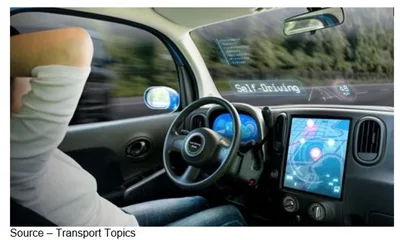
Wireless economy is interpreted as being easier for folks to monetize the cellular system with added revenue streams like ad placement and yes, streaming entertainment.
As one advocate said, “it will improve the passenger experience,” which has always been telcos’ first priority!
But in the short term (5-10 years), autonomous vehicles will have to share the road with human drivers.
Onboard processing with infotainment systems like Harman’s will be more important to self-driving L5 cars initially than cloud computing; but by 2030 when L5 vehicles become more prevalent, the systems and vehicles will be exchanging information with the outside world.
During the transition, humans behind the wheel will have to react to unpredictable driving conditions like road obstructions/construction, rain and snow; and yes, in areas where connectivity isn’t so great.
Everyone else?
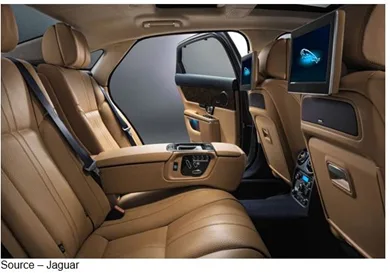
Intel’s Davis told the SMPTE attendees, “Autonomous vehicles are the unseen driving force of the next wave of innovation. It will redefine the way we experience life, work, school and home, making experiences possible we never thought we’d have”
As soon as G5 technology is widely deployed in 3-5 years, passengers will be able to enjoy Netflix, Disney+, Amazon Prime, Hulu or other streaming 4K content while the driver focuses on the cars next to them.
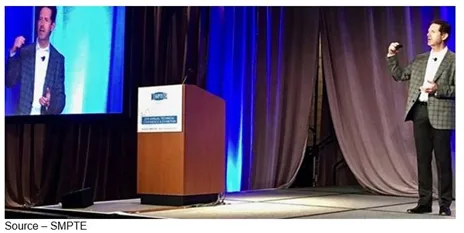
He noted that Intel commissioned a study by Strategy Analytics called ‘The Passenger Economy’ that predicted that explosion to generate $7T from this new ubiquitously connected technology when cars become the most significant mobile data generating and consuming device that we use.
From his perspective, the rise of autonomous cars will be the most ambitious project of our collective lifetime.
Worldwide revenue of autonomous vehicles is estimated to grow to $103 billion by the end of 2022, according to Tractica.
Davis emphasized that the demand will be driven by the extra convenience for drivers, safety improvements and vehicle connectivity.
He said VR will play a major role in filling this abundance of relaxation time.
Davis suggested that the interior of a driverless car could be the perfect environment for encapsulating new experiences and expanding the idea of volumetric capture technology that can put the viewer inside a three-dimensional VR movie scene.
“You could see the POV of the hero or the villain,” he said. “Or, on the sports field, you could see a football game from the perspective of the quarterback.”
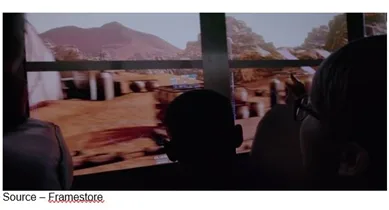
To give the SMPTE audience a glimpse of tomorrow’s VR entertainment/travel, Framestore’s Mike McGee showed clips of a Lockheed Martin/McCann project they had done called Field Trip to Mars.
This was the first-ever headset-free group virtual reality vehicle experience. The windows of a school bus were replaced with transparent 4K screens to transport passengers to the surface of the Red Planet as well as the scenery of Washington D.C. they were passing.
They were able to see the rocks, dirt and mountains we recognize from satellite photographs of the planet as well as the new model of the rover Curiosity, a space colony, and Lockheed’s Orion capsule for the upcoming Mars mission.
The film of the travels was great, but it would have been even better to be in the bus checking out all the sights of the place our kids’ kids will be able to see firsthand.
And yes, they’ll be doing it in electric autonomous vehicles, probably watching 8K plus films from back home.

Of course, we’ll be stuck down here with Judge Doom who will blissfully say, “Eight lanes of shimmering cement running from here to Pasadena. Smooth, safe, fast. Traffic jams will be a thing of the past.”
Okay … only in the movies.
# # #